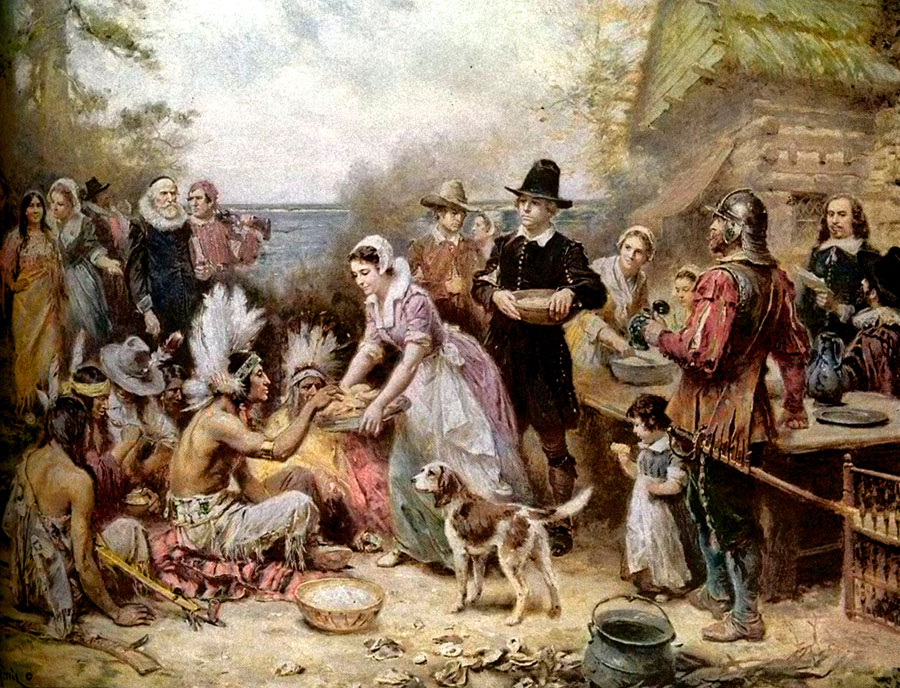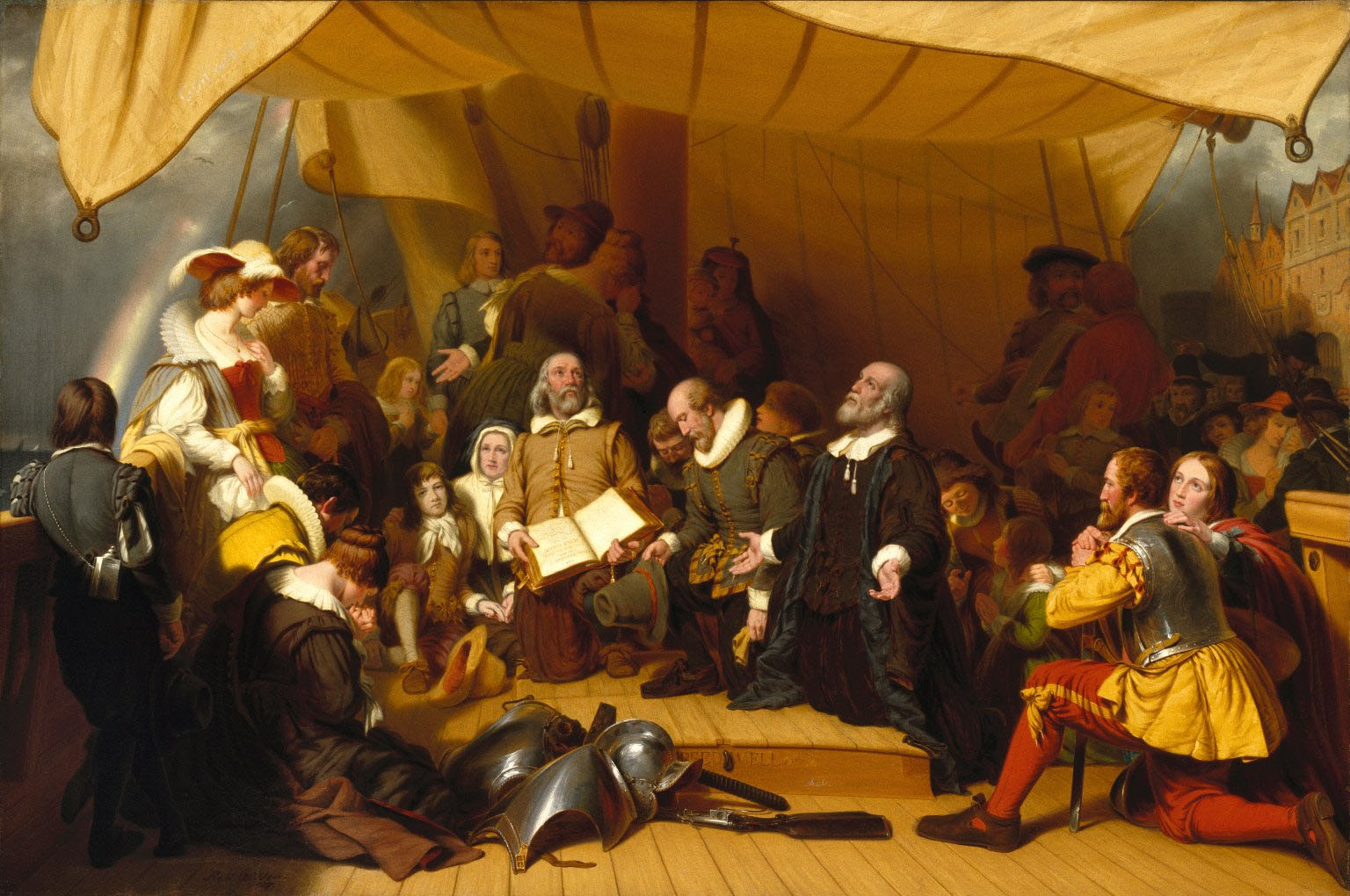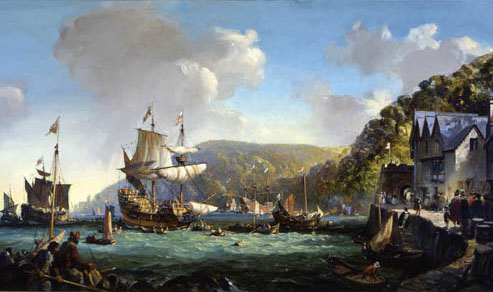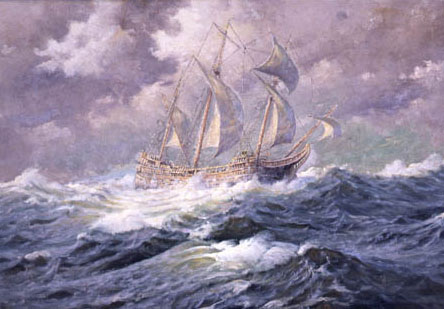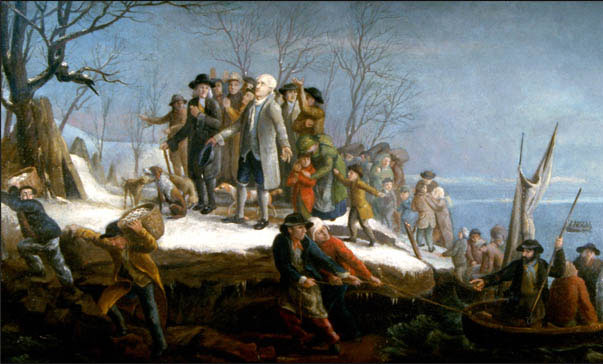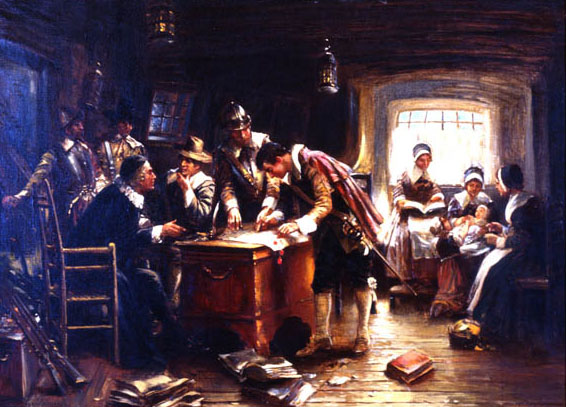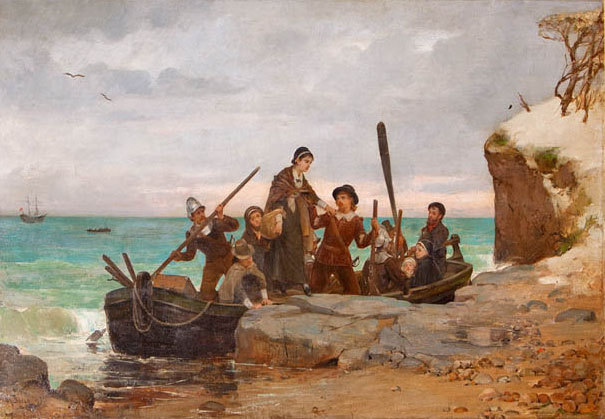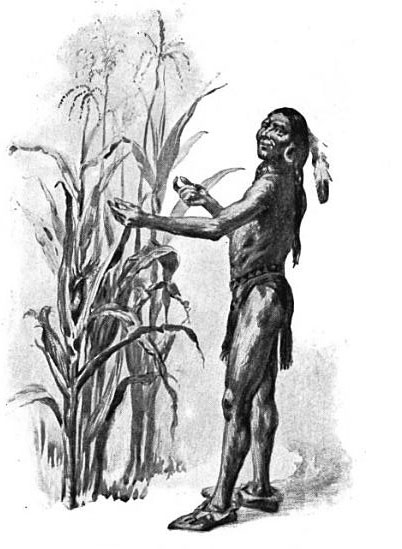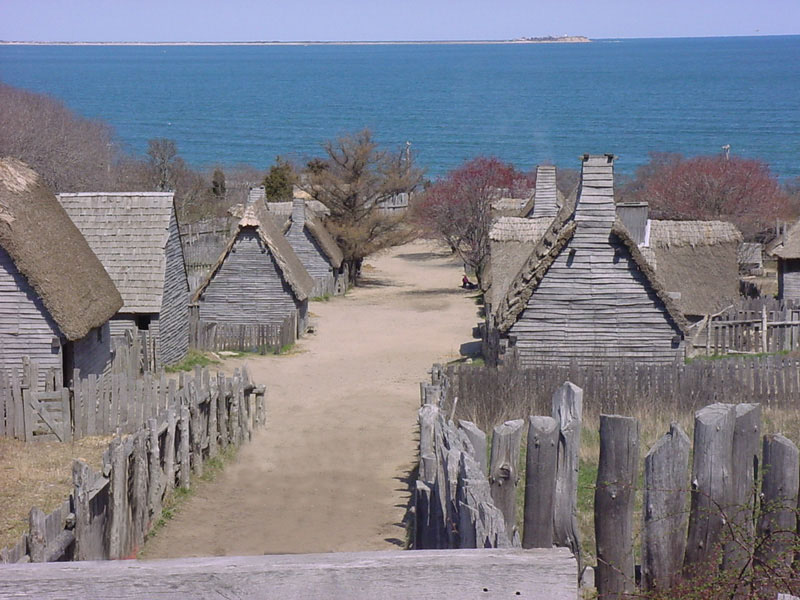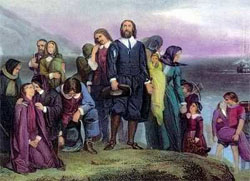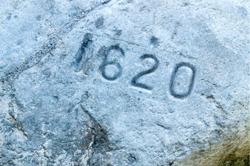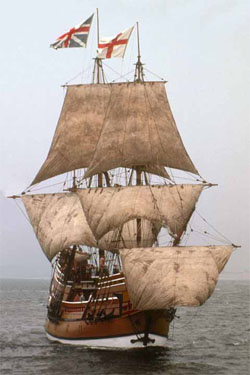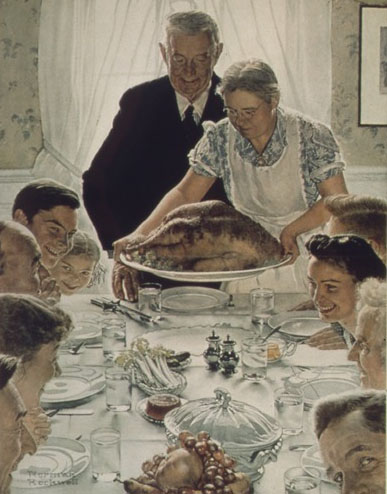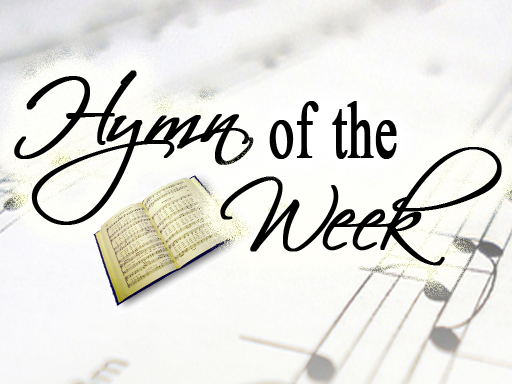The Story of the Pilgrims
The Pilgrim Connection to Thanksgiving
If you read our Thanksgiving History page, than you know that Americans did not originally associate Pilgrims with the holiday.1 It was in the year 1841 that Rev. Alexander Young identified the Plymouth harvest feast of 1621 as the first American Thanksgiving.2 Regardless, the association between Pilgrims and Thanksgiving did not immediately take root. In fact, the common Thanksgiving symbols of the 19thcentury centered on turkeys, Yankee dinners, and annual family reunions, not Pilgrims. According to historian Jim Baker, the former director of research at the Plimoth Plantation:
“Moreover, whenever a Pilgrim, or more accurately, a generic 17th-century puritan image, appeared in popular art in connection with Thanksgiving during the nineteenth century, it was not the now familiar scene of English and Indians sitting down to an outdoor feast. On the contrary, the image almost always portrayed a violent confrontation between colonist and Native American. It was only after the turn of the century . . . that the romantic (and historically correct) idyllic image of the two cultures sitting down to an autumn feast became popular. By the First World War, popular art (especially postcards), schoolbooks and literature had linked the Pilgrims and the First Thanksgiving indivisibly together.”3
It comes as no surprise that Americans eventually embraced the connection between Thanksgiving and the Pilgrims. Without a doubt, the Pilgrim story is one of the most moving and inspiring accounts in American history. Of the Pilgrims, historian Dr. Samuel Eliot Morison wrote:
“The Pilgrims: a simple people, inspired by an ardent faith in God, a dauntless courage in danger, a boundless resourcefulness in the face of difficulties, an impregnable fortitude in adversity: thus they have in some measure become the spiritual ancestors of all Americans.”4
The remarkable story of the Pilgrims is told below. It is drawn mainly from Bradford’s History of the Plymouth Settlement, 1608-1650. The author, William Bradford, was one of the Pilgrims, as well as a long time governor of the Plymouth Plantation. He gives a first-hand account of the Pilgrim story.
The Beginning (The Scrooby Congregation)
The Pilgrim story begins with a group of Christian “Separatists” (or “Dissidents”) who chose to separate themselves from the Church of England. They believed that the church was in need of greater reform than was possible in the king’s established church (interestingly, the king at this time was James I, famous for commissioning the King James Version of the Bible). They have also been called “Puritans,” but this term is not quite accurate. For a helpful article that explains the difference between Pilgrims and Puritans, visit Puritan Sermons.com.
At a time when the Church and State were one in England, Separatists were considered treasonous and were in constant danger of persecution or imprisonment. For this reason, a small group of Separatists from the village of Scrooby (in north Nottinghamshire) determined that they had to flee from England. Unfortunately, they were caught on their first attempt to leave, and they were imprisoned. However, a second attempt in 1609 proved successful, and they escaped to the tolerant haven of Holland.
Time in Holland
For 12 years, they gathered openly for church under the leadership of Pastor John Robinson. But life in a foreign country proved to be difficult. The only work available to immigrants was poorly paid, and they constantly struggled with poverty. Furthermore, they watched their children assimilating into the Dutch culture and abandoning their parents’ values. William Bradford, later governor of the Plymouth Plantation, wrote:
“Of all the sorrows most heavy to be borne (in Holland), was that many of the children, influenced by these conditions, and the great licentiousness of the young people of the country, and the many temptations of the city, were led by evil example into dangerous courses, getting the reins off their necks and leaving their parents. Some became soldiers, others embarked upon voyages by sea and others upon worse courses tending to dissoluteness and the danger of their souls, to the great grief of the parents and the dishonour of God. So they saw their posterity would be in danger to degenerate and become corrupt.”5
These disheartened Pilgrims began to dream of finding a new place to call home – one with an environment more favorable for raising children with their Christian values. Furthermore, they had a deep desire to bring the gospel to people who had not yet heard the marvelous message of Jesus Christ:
“They cherished a great hope and inward zeal of laying good foundations, or at least of making some way towards it, for the propogation and advance of the gospel of the kingdom of Christ in the remote parts of the world, even though they should be but stepping stones to others in the performance of so great a work.”6
So in 1618, the Pilgrims in Leiden made the historic decision to emigrate again.
Departure to America
After much consideration, the Pilgrims decided to travel to the northernmost part of the Virginia Company Grant, at the mouth of the Hudson River. A group of English investors called the “Merchant Adventurers” agreed to finance the voyage and settlement in exchange for 7 years of labor from the settlers. The Pilgrims bought a small ship called the Speedwell and sailed to England in July 1620 to meet up with the other colonists and a larger hired ship called the Mayflower. Preparations were completed on August 5, and the two ships set sail. Unfortunately, the Speedwell leaked badly and forced the ships to turn back twice. The Pilgrims were ultimately forced to abandon the Speedwell at Plymouth, England and crowd as many people as possible onto the Mayflower. About 20 passengers had to be left behind.
Finally, on September 6, 1620, the Mayflower set sail across the North Atlantic with its famous 102 passengers. You can learn more about the Mayflower and its passengers on our Mayflower page.
The Voyage
The beginning of the voyage was pleasant with a “prosperous wind.” However, the smooth start was interrupted by harsh storms that tragically cracked a main beam. The conditions were so severe that some thought of turning back. But in the end, “they committed themselves to the will of God and resolved to proceed.”7
There were only two casualties during the voyage. One was a sailor who was always cursing and swearing at the passengers. He died in a “desperate manner” of a “grievous disease” such that even his mates thought it was the “just hand of God upon him.”8 The other death among the passengers was a youth by the name of William Butten, a servant of Samuel Fuller. There was nearly a third fatality when John Howland was swept overboard during a storm, but he was able to grab hold of a rope and be pulled back up to safety. There was also a birth during the voyage. Elizabeth Hopkins had a son, who was appropriately named “Oceanus.”
On November 9, 1620, the Mayflower sighted land. It proved to be Cape Cod. This was well east of the original destination; however, winter was fast approaching, and sandbars prevented the ship from sailing further, so they decided to anchor in what is now Provincetown Harbor on November 11. After 66 days at sea, Bradford recounts:
“Having found a good haven and being brought safely in sight of land, they fell upon their knees and blessed the God of Heaven who had brought them over the vast and furious ocean, and delivered them from all the perils and miseries of it, again to set their feet upon the firm and stable earth, their proper element.”10
Yet, in the midst of the happiness of reaching land, the reality of their situation quickly became clear. Bradford writes:
“But here I cannot but make a pause, and stand half amazed at this poor people’s present condition ; and so I think will the reader, too, when he considers it well. Having thus passed the vast ocean, and that sea of troubles before while they were making their preparations, they now had no friends to welcome them, nor inns to entertain and refresh their weatherbeaten bodies, nor houses – much less towns — to repair to.”10
Bradford continues:
“What, then, could now sustain them but the spirit of God, and His grace? Ought not the children of their fathers rightly to say: Our fathers were Englishmen who came over the great ocean, and were ready to perish in this wilderness; but they cried unto the Lord, and He heard their voice, and looked on their adversity. . . . Let them therefore praise the Lord, because He is good, and His mercies endure forever. Yea, let them that have been redeemed of the Lord, show how He hath delivered them from the hand of the oppressor. When they wandered forth into the desert-wilderness, out of the way, and found no city to dwell in, both hungry and thirsty, their soul was overwhelmed in them. Let them confess before the Lord His loving kindness, and His wonderful works before the sons of men!”11
On arrival in Provincetown, Cape Cod, some of the colonists (Bradford called them “strangers” to distinguish them from the people of his congregation) began to argue. They claimed that since they had landed in New England (instead of Virginia), their charter, as well as the contract with the Merchant Adventures, did not apply to them and that “none had power to command them.”12 It became clear that the colonists were going to need some kind of compact if they wanted to have any form of civil government.
Thus, to preserve order until a new charter could be obtained from England, the colonists created the famous Mayflower Compact — signed by all the male colonists. This Compact is seen as one of the earliest examples of democracy in America. President John Quincy Adams said of it, “Here was a unanimous and personal assent by all the individuals of the community to the association by which they became a nation.”
After signing the Compact, the colonists confirmed John Carver as their first governor. He was “a godly man and highly approved among them.” Carver had been a wealthy London merchant before leaving for Holland with the Scrooby congregation. He was instrumental in securing a charter, as well as financial support, for the establishment of a colony in America. He was a natural leader, and William Bradford gives us insight into Carver’s leadership:
“In these arduous and difficult beginnings, discontent and murmuring arose amongst some, and mutinous speech and bearing in others; but they were soon quelled and overcome by the wisdom, patience, and just and equal administration of things by the Governor and the better part, who held faithfully together in the main.”13
Exploration
During the course of the next several weeks, while most of the colonists stayed aboard the Mayflower, exploration parties (under the command of Captain Miles Standish) went out to evaluate the immediate area. After many challenges (including a fierce storm and an attack by Native Americans – in which no none was injured), the exploration party found what seemed to be a suitable place to build their new community. On Monday, December 11, 1620, the men sailed their shallop (a sailboat brought on the Mayflower that was used for exploration) to the shore of Plymouth (named by Captain John Smith who had arrived there in 1614). Though there is no record of it, this is when the famous landing on Plymouth Rock is thought to have occurred. Five days later, on December 16, the Mayflower arrived in Plymouth harbor, and construction on the settlement began on December 23. During the short stay in Provincetown, there were 4 deaths, and one birth (Peregrine White).
The First Winter
Unfortunately, the colonists were not able to finish their building before a terrible winter set in. Though the Mayflower, as well as some of the completed structures on land, provided modest defense against the elements, many still fell ill due to exposure and malnutrition. At one point, only seven people were healthy enough to tend the sick.
William Bradford records:
“In the time of worst distress, there were but six or seven sound persons, who, to their great commendation be it spoken, spared no pains night or day, but with great toil and at the risk of their own health, fetched wood, made fires, prepared food for the sick, made their beds, washed their infected clothes, dressed and undressed them ; in a word did all the homely and necessary services for them which dainty and queasy stomachs cannot endure to hear mentioned; and all this they did willingly and cheerfully, without the least grudging, showing their love to the friends and brethren ; a rare example, and worthy to be remembered. Two of these seven were Mr. William Brewster, their reverend elder, and Myles Standish, their captain and military commander, to whom myself and many others were much beholden in our low and sick condition. And yet the Lord so upheld these men, that in this general calamity they were not at all infected with sickness. And what I have said of these few, I should say of many others who died in this general visitation, and others yet living, that while they had health or strength, they forsook none that had need of them. I doubt not that their recompense is with the Lord.”14
Bradford continues:
“But I must not pass by another remarkable and unforgettable occurrence. When this calamity fell among the passengers who were to be left here to settle, they were hurried [off the Mayflower] . . . Then the disease began to seize the sailors also . . . But amongst the sailors there was quite a different bearing in their misery. Those who before, in the time of their health and welfare, had been boon companions in drinking and jollity, began now to desert one another, saying they would not risk their lives for the sick among them, lest they should be infected by coming to help them in their cabins ; if they died, let them die! But the passengers who were still aboard showed them what pity they could, which made some of their hearts relent, such as the boatswain, who was an overbearing young man, and before would often curse and scoff at the passengers. But when he grew weak they had compassion on him and helped him. Then he confessed he did not deserve it at their hands, for he had abused them in word and deed. ‘Oh,’ said he, ‘you I see now, show your love like Christians indeed to one another; but we let one another lie and die like dogs.’”15
Tragically, by the end of the winter, half of the colonists, as well as half of the crew, had died.
Meeting the Native Americans
As spring approached, and as health improved among the surviving colonists, they set to work building their new settlement. On a nearby hill, the Village Street was laid out, and it was lined on each side with plots for homes and gardens. On the top of the hill, the men erected a cannon for defense.
On March 16, 1621, as the colonists were busy planting their garden seeds, a Native American by the name of Samoset (from the Abenaki Sagamore tribe) approached them saying, “Welcome Englishmen.” Samoset had learned English from fishermen who crossed the North Atlantic each year to fish for cod. Samoset proved to be a friend to the colonists, and on March 22, he introduced them to another Native American named Squanto (or Tisquantum).
The colonists learned that their new home had once belonged to Squanto’s tribe, the Patuxet people, who had all been killed by a plague. Squanto was alive only because he had been in Europe during the plague. He had been kidnapped by an English captain named Thomas Hunt. Captain John Smith had left Hunt in Plymouth to continue trading with the Indians, but Hunt betrayed Smith, kidnapped more than twenty Patuxet, and sold them as slaves in Malaga, Spain. Squanto later escaped to London and eventually made his way back to America – only to find that his tribe had been wiped out by a plague.
Despite this tragedy, God had unique plans for Squanto. The Pilgrims viewed Squanto as a providential blessing from God. Not only did Squanto serve as their chief interpreter and agent in the colonists’ interaction with the Native Americans, he also showed them how to survive on the land.
Bradford writes of Squanto:
“But Squanto stayed with them [the colonists], and was their interpreter, and became a special instrument sent of God for their good, beyond their expectation. He showed them how to plant their corn, where to take fish and other commodities, and guided them to unknown places, and never left them till he died.”16
Squanto also helped to pave the way for a meeting with Massasoit, chief of the Wampanoag and the most important leader in the region. After exchanging gifts and greetings, the colonists and the Wampanoag signed a peace treaty that would last over 50 years.
The Thanksgiving Feast of 1621
Miraculously, by the time fall of 1621 arrived, the Plymouth Plantation was thriving. Bradford writes of the harvest:
“They began now to gather in the small harvest they had and to fit up their houses and dwellings against winter, being all well recovered in health and strength and had all things in good plenty. For as some were thus employed in affairs abroad, others were exercised in fishing, about cod and bass and other fish, of which they took good store, of which every family had their portion. All the summer there was no want; and now began to come in store of fowl, as winter approached, of which this place did abound when they came first (but afterward decreased by degrees). And besides waterfowl there was great store of wild turkeys, of which they took many, besides venison, etc. Besides, they had about a peck of meal a week to a person, or now since harvest, Indian corn to that proportion. Which made many afterwards write so largely of their plenty here to their friends in England, which were not feigned but true reports.”17
The only primary source document we have for what has come to be called the “First Thanksgiving” is from Edward Winslow’s account in Mourt’s Relation:
“Our harvest being gotten in, our governor sent four men on fowling, that so we might after a special manner rejoice together, after we had gathered the fruits of our labors; they four in one day killed as much fowl, as with a little help beside, served the Company almost a week, at which time amongst other Recreations, we exercised our Arms, many of the Indians coming amongst us, and amongst the rest their greatest king Massasoit, with some ninety men, whom for three days we entertained and feasted, and they went out and killed five Deer, which they brought to the Plantation and bestowed on our Governor, and upon the Captain and others. And although it be not always so plentiful, as it was at this time with us, yet by the goodness of God, we are so far from want, that we often wish you partakers of our plenty.”18
And thus, fifty three colonists and ninety Native Americans celebrated for three days with feasting and games.
One cannot help but be struck by the radical shift in the condition of the Pilgrims – one of desperate want to absolute abundance. Yet, in the midst of both circumstances, the Pilgrims were always mindful of the providence of their gracious God. They humbly accepted the will of God, whatever it may be, and they were prepared to make tremendous sacrifices for future generations. Perhaps for the sake of these faithful Pilgrims, God chose to pour out his blessing on their descendants and their new country. To use the words of Bradford, these Pilgrims indeed became the “stepping stones” in the formation of what has arguably become the greatest nation on earth.
This page was created by:

We welcome your ideas! If you have suggestions on how to improve this page, please contact us.
You may freely use this content if you cite the source and/or link back to this page.
NOTES:
1 The term “pilgrim” was first used by William Bradford, governor of the Plymouth Plantation, to describe the members of his church – Puritans who traveled from England to Holland and then on to America seeking religious freedom. Though the name has come to be associated with all of the Plymouth Plantation colonists, it is mainly used in this article to refer to the Puritan church members.
2 Baker, James. Thanksgiving, The Biography of an American Holiday. University of New Hampshire Press, 2009, p.13.
3 Baker, Jim. “The ‘First Thanksgiving’: Facts and Fancies,” 1999.
4 Morison, Dr. Samuel Eliot, Introduction to Of Plymouth Plantation, 1620-1647, p.xii.
5 Bradford, William. Bradford’s History of the Plymouth Settlement, 1608-1650. Rendered into modern English by Harold Paget. E.P. Dutton & Company, 1920, p. 21.
6 Bradford’s History, p. 21.
7 Bradford’s History, p. 63.
8 Bradford’s History, p. 62.
9 Bradford’s History, p.64.
10 Bradford’s History, pp. 64-65.
11 Bradford’s History, p. 66.
12 Bradford’s History, p.75.
13 Bradford’s History, p. 76.
14 Bradford’s History, p. 77.
15 Bradford’s History, p. 77-78.
16 Bradford’s History, p. 80.
17 Bradford’s History, p. 89.
18 Winslow, Edward.Mourt’s Relation: A Journal of the Pilgrims at Plymouth. Applewood Books, 1986 (originally printed in 1622), p. 82.
IMAGE CREDITS:
“The First Thanksgiving,” by Jean Leon Jerome Ferris at Wikimedia Commons.
“Embarkation of the Pilgrims,” by Robert Walter Weir at Wikimedia Commons.
“The Mayflower and Speedwell in Dartmouth Harbor,” by Leslie Wilcox at Pilgrim Hall Museum.
“The Mayflower at Sea,” by Gilbert Margeson at Pilgrim Hall Museum.
“The Landing of the Pilgrims,” by an Anonymous Artist at Pilgrim Hall Museum.
“The Signing of the Compact in the Cabin of the Mayflower,” by Edward Percy Moran at Pilgrim Hall Museum.
“The Landing of the Pilgrims (at Plymouth),” by Henry A. Bacon at Pilgrim Hall Museum.
“Squanto,” image from The Teaching of Agriculture at Wikimedia Commons.
Plymouth Plantation Photo by Melinda Kolk at Pics for Learning.
